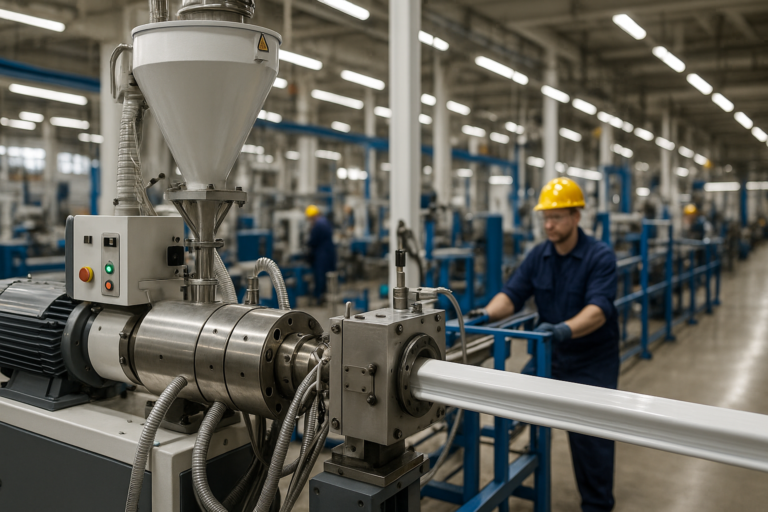Make some changes to the world environment
-
Building 3, Wanyang Innovation City, Langxia Street, Yuyao City, Zhejiang Province
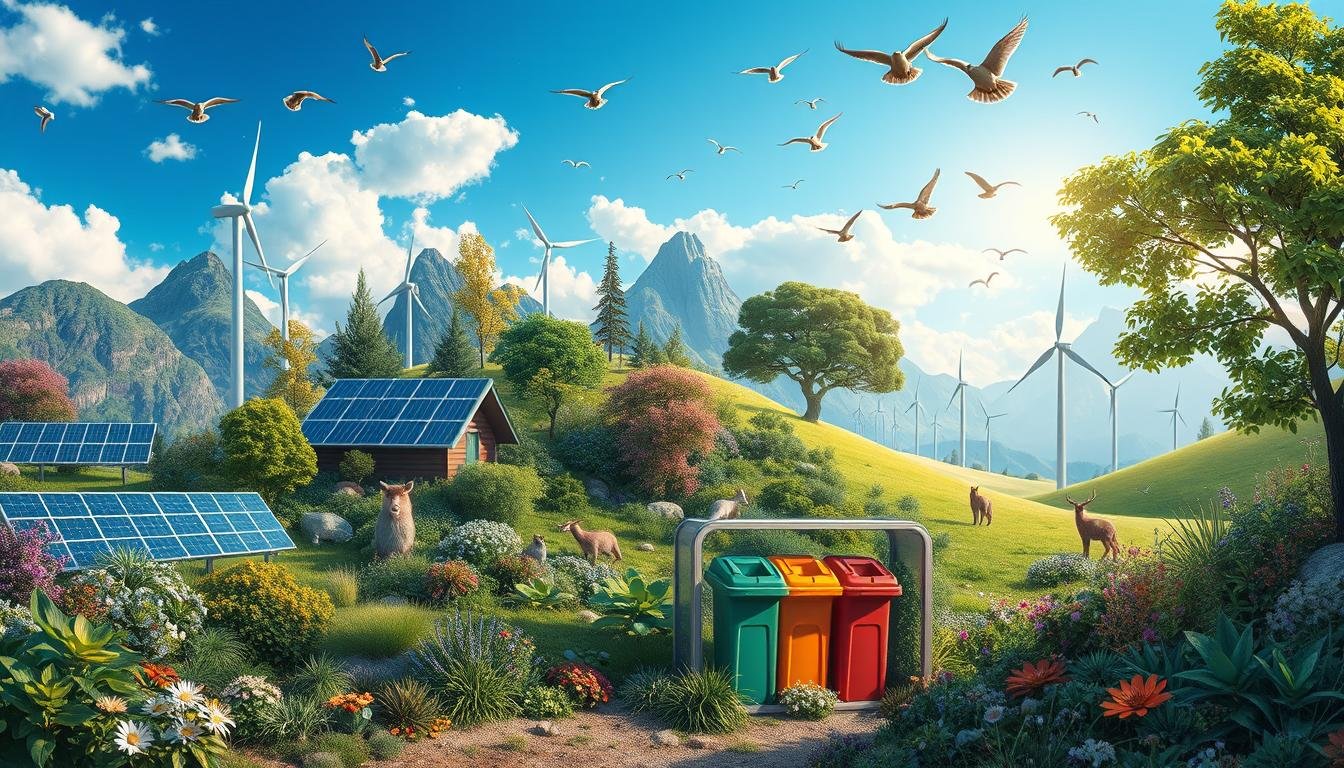
Plastic and Recycling Facts: What You Need to Know
Have you ever wondered what really happens to your plastic water bottle once it’s tossed into the recycling bin?
The reality of plastic recycling is far more complex than most of us realize. Not all plastics are created equal: they are classified into 7 different categories based on their Resin Identification Codes (RIC). For example, #1 PET plastics, commonly used for water bottles, have the highest recycling value, whereas thermoplastics can be recycled and thermoset plastics cannot1. Moreover, recycling isn’t as straightforward as many think; it involves market demands, local regulations, and conscientious consumer behavior.
In the U.S., recycling levels are currently at just 21.4% according to a recent EPA-funded Yale University study2. However, increasing these levels can have profound benefits. For instance, reaching a 75% recycling rate would be the environmental equivalent of removing 55 million cars from U.S. roads each year and would generate 1.5 million new jobs2. This demonstrates the significant environmental impact and economic benefits that effective recycling can have on our society.
To truly make an impact and foster sustainability, it’s vital to understand not only the recycling process but also the lifecycle of the materials we consume. We’ll delve into these intricacies throughout this article, offering recycling tips that can help ensure you’re part of the solution rather than the problem.
Key Takeaways
- The classification of plastics into 7 categories determines their recyclability1.
- #1 PET plastics have the highest recycling value1.
- U.S. recycling levels are currently at 21.4%2.
- A 75% recycling rate in the U.S. could remove the equivalent of 55 million cars’ worth of CO2 emissions per year2.
- Effective recycling involves understanding the lifecycle and proper sorting of materials.
The Complexity of Plastic Recycling
The complexity of plastic recycling lies in understanding the lifecycle of recyclable materials and the myriad factors influencing it. One of the primary determinants of recycling effectiveness is The Role of Market Demand and Local Regulations. For instance, about 10 to 15 percent of the material sent to U.S. recycling centers is not recyclable and ends up in local landfills3. This situation highlights the challenges faced by recycling centers in handling non-recyclable waste.
Moreover, paper, plastic, and metal can only be sold if they meet specific standards, such as not containing other materials3. The stringent recycling regulations ensure that materials are free from contaminants and can be efficiently processed. In 2021, only about 5-6% of plastic waste in the U.S. was recycled, showcasing the low rate of recycling efficacy4.
A significant issue in plastic recycling is that most “recycled” plastic bottles end up as plastic fiber for clothing, plastic film, or industrial plastic wrap, rather than being turned back into food and beverage containers4. This trend is largely driven by market demand in recycling, as the demand for recycled plastics in specific applications heavily influences the recycling lifecycle’s outcomes.
In 2021, almost one third of supposedly “recycled” bottles were burned or buried due to contamination or material losses4. Lightweight plastics, favored by packaging manufacturers, are often not recyclable, further complicating the recycling process3. Such regulations ensure that only high-quality recyclable materials are processed, reducing the risk of contamination and improving the recycling lifecycle’s efficiency.
The role of public investment in The Role of Market Demand and Local Regulations cannot be underestimated. Public investment is crucial for developing and maintaining the infrastructure required for efficient sorting and processing of recyclable materials. Additionally, almost 28% of #1 plastic bottles in the U.S. are recycled, but only a fraction of those bottles are turned back into food and beverage containers4. This data underscores the importance of adequate facilities and technologies to handle and repurpose recycled plastics effectively.
Undoubtedly, the complexity of plastic recycling is a multifaceted issue that necessitates a nuanced understanding of various factors such as market demand and local recycling regulations. Through strategic public investment and adherence to stringent regulations, we can enhance the recyclability of materials and contribute to a sustainable recycling lifecycle3.
Types of Plastics and Their Recyclability
Plastics are categorized by Resin Identification Codes (RIC), which range from 1 to 7, indicating their recyclability options. For instance, Polyethylene Terephthalate (PET), labeled as RIC 1, is the most widely recycled plastic globally, with approximately 7.5 million tons collected worldwide in 2011. Nations like India, Europe, and South Korea have PET recycling rates higher than 50%, while countries such as the US and China strive to improve their recycling capabilities5. On the contrary, Polyvinyl Chloride (PVC) marked as RIC 3, and plastics in categories 6 (Polystyrene) and 7 (other), are generally not recycled5.
Understanding the difference between thermoplastics and thermoset plastics is crucial. Thermoplastics, such as PET and High Density Polyethylene (HDPE), can be remelted and reused, making them more environmentally friendly5. In contrast, thermoset plastics cannot be reshaped or recycled once they have been set. Resin Identification Codes (RIC) Explained aid consumers and businesses in determining which plastics are suitable for recycling. For example, the recycling rate for HDPE bottles in the US is around 30%, whereas less than 3% of Polypropylene (PP) is recycled5.
It’s equally important to recognize the health risks of various plastics. Some compounds in plastics can disrupt hormones and lead to potential toxicity. Non-recyclable plastics, such as composite plastics and bioplastics, exacerbate waste management challenges and environmental impacts6. For instance, certain plastic types can take between 500 to 1000 years to biodegrade, resulting in persistent pollution if not recycled6.
The origin of most plastics is from crude oil, underscoring the broader environmental stakes involved in production and disposal. Businesses must confirm which plastics are accepted for recycling with their waste management providers, as standards and capabilities may differ6.
- PET or PETE: Can be recycled
- HDPE: Can be recycled
- LDPE: Sometimes can be recycled
- PP: Sometimes can be recycled
- PS: Sometimes can be recycled
- PVC: Cannot be recycled
- Other plastics: Sometimes can be recycled
In Massachusetts, for instance, disposal of single resin narrow-necked bottles in trash bins is prohibited, reinforcing the need for comprehensive recycling programs7. Plastic waste that isn’t recycled often ends up in landfills, yet certain plastics can be repurposed to prolong their utility. The proper separation of thin plastic bags and films can prevent machinery clogging in recycling facilities6. Therefore, understanding the different types of plastics and their recyclability ensures that we minimize environmental harm while maximizing recycling efficiency.
Coffee Cups and Recycling Challenges
The environmental impact of recycling coffee cups is a significant concern due to the intricate composite materials used. Most coffee cups are comprised of paper with a thin plastic lining, making them difficult to recycle through standard curbside programs. As a result, a staggering 99.75% of plastic-coated coffee cups cannot be recycled due to contamination issues8. This leads us to face composite materials recycling challenges which require specialized processes not readily available in many regions9.
Moreover, the production of paper cups consumes vast amounts of resources. Shockingly, 6.5 million trees are cut down annually to produce the 16 billion paper coffee cups used each year9. Additionally, these cups contribute significantly to carbon emissions. For instance, each paper cup with a plastic lining emits around 110 grams of CO2 during production, while plastic cups emit between 10 to 30 grams depending on the type9. This further complicates the recycling process and underscores the necessity of seeking sustainable alternatives.
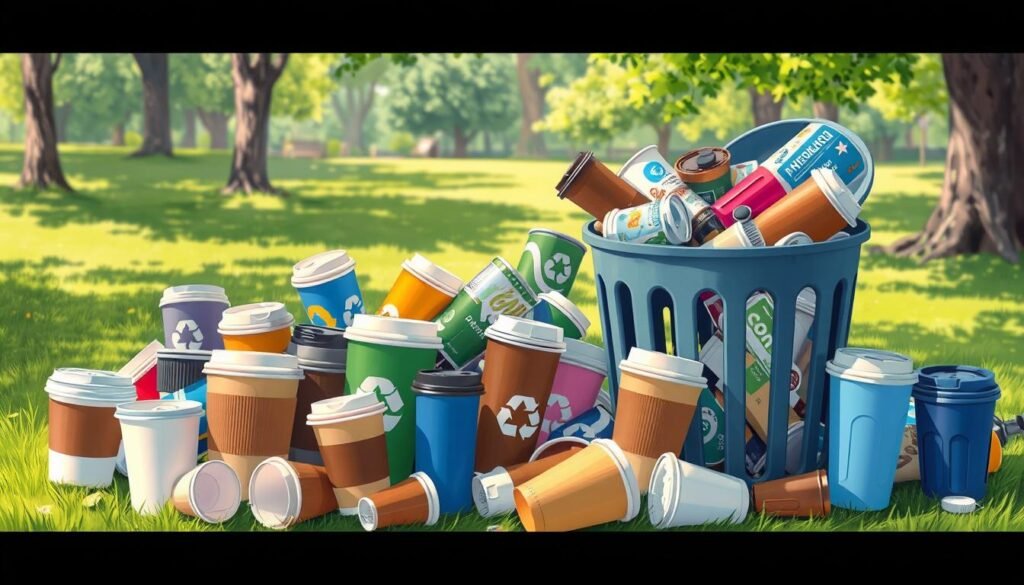
To mitigate the recycling coffee cups problem, a shift towards reusable or more sustainable options is imperative. Globally, approximately 500 billion paper coffee cups are produced every year, exacerbating the waste issue8. Furthermore, the release of microplastics from plastic linings in coffee cups is another pressing concern, with a mere three hot beverages potentially leading to an ingestion of 75,000 microplastic particles8. Sustainable alternatives such as PLA-lined cups and bamboo paper cups are being explored but have not yet achieved widespread adoption.
For comparison, consider the environmental toll of single-use coffee cups versus reusable options:
| Single-Use Cups | Reusable Cups |
|---|---|
| 16 billion used globally each year10 | Need to be used 20-100 times to offset production emissions9 |
| 6.5 million trees cut annually for production9 | Reduces single-use waste significantly |
| Paper cups emit 110g of CO2 per cup9, plastic cups emit 10-30g | Reduces overall carbon footprint |
| Contribute to microplastic pollution8 | Eliminates plastic waste concerns |
To further emphasize the importance of reducing single-use coffee cups, consider the environmental harm caused by 10 million tons of plastic ending up in oceans each year9. By encouraging practices such as offering discounts for customers who bring their own cups or adopting new ordinances to limit single-use plastics, we can make strides towards a more sustainable future. Read more about the environmental impact of coffee cups here9.
Ensuring Recyclable Quality: Clean Plastics
Ensuring the quality of recyclable plastics starts with the consumer’s responsibility. The impact of food residues on recycling cannot be overstated. Materials accepted in local recycling programs need to be empty, clean, and dry to be sent to recycling markets and made into something new11. The cleaner the materials are, the more valuable they become to recyclers, as most recycling facilities do not clean recyclables11.
Properly cleaned plastics significantly enhance the efficiency of recycling processes. Recycling facilities have expressed that contaminated recyclables often end up in landfills instead of being processed into new materials12. This is particularly crucial for materials like PET bottles and jars, which had a recycling rate of 29.1% in 2018, and HDPE natural bottles, recycled at a rate of 29.3% in the same year13. The presence of food residues diminishes the recyclability of these plastics, demanding thorough cleansing before they reach recycling bins.
“Single-stream recycling simplifies the process for consumers, yet the need for clean, food residue-free recyclables remains paramount to ensure effective recycling”13.
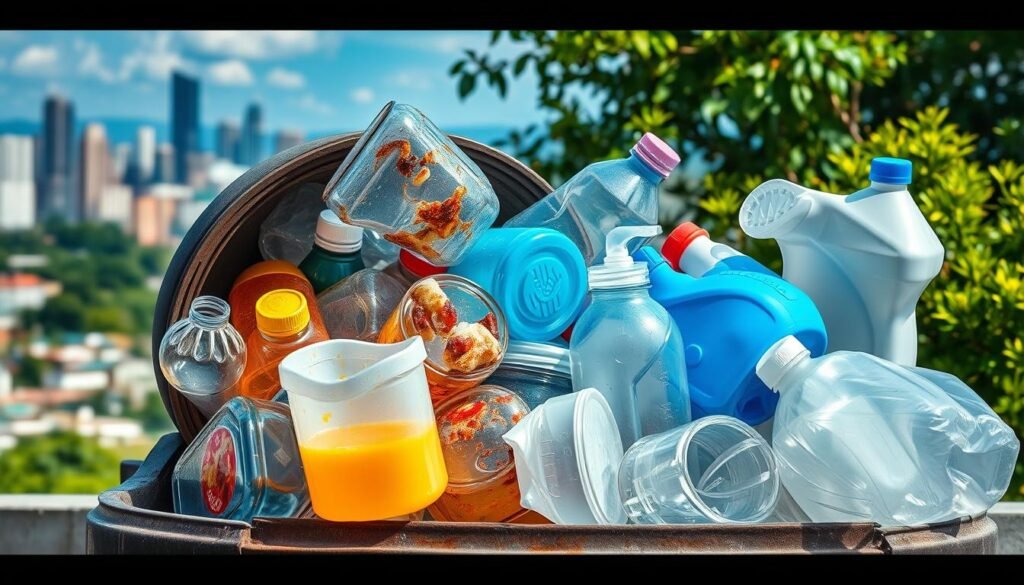
Several success stories underline the importance of clean recycling practices. For example, the high participation rates in single-stream recycling can be partly attributed to its convenience, though the contamination levels must be kept low for the system to be effective12. San Francisco boasts a sophisticated recycling infrastructure with million-dollar machines that separate recyclables, indicating the importance of local initiative and investment13. In contrast, Blaine County, Idaho, faces challenges in justifying such expenses, highlighting the disparity in recycling capabilities across different regions13.
Ultimately, it is the impact of food residues on recycling that can make or break the recycling loop. Through effective consumer education and proper waste management practices, the quality of recyclable materials can improve, leading to more successful recycling initiatives. We must remember that recyclables don’t need to be perfectly clean but should be emptied to prevent contamination12. By focusing on the cleanliness of plastics, we can significantly enhance their recyclability, ensuring they are efficiently processed and repurposed.
Plastic and Recycling Facts You Should Know
The journey of recycling is one marked with significant milestones and challenges. The Recycling History and Its Evolution reveal that while we’ve made substantial progress, hurdles remain. For instance, in 2018, American consumers generated 146.2 million tons of trash that ended up in landfills while recycling almost 94 million tons of waste, reflecting a 300% growth in recycling over the past 38 years14.
Understanding the environmental impact of different materials is crucial. Plastic bags, due to their lightweight and widespread use, contribute significantly to plastic bags pollution. By contrast, aluminum and glass are infinitely recyclable, illustrating the varied history of recycling across materials15.
The quality of recycled products often degrades with each recycling cycle. Plastic, in particular, suffers from this issue, leading to its downgrading to products of lesser quality. For instance, recycled plastic containers can be turned into items such as cell phone cases, playground equipment, and even clothes and rugs14.
Moreover, recycling initiatives highlight stark contrasts in effectiveness. For example, while plastic bags pose a challenge, aluminum cans can return to the shelf in just 60 days after being recycled14, and 2.4 million tons of recycled glass are used annually to produce new bottles and jars14.
Throughout Recycling History and Its Evolution, several facts stand out. The United States recycles sufficient iron and steel scrap metals annually to construct over 900 Golden Gate Bridges14. Meanwhile, recycling one aluminum can save enough energy to power a 55-inch HDTV to watch a movie, illustrating the tangible benefits of effective recycling practices15.
Additionally, recycling helps conserve raw materials, lessening the environmental burden. For each ton of glass recycled, more than a ton of natural resources gets preserved16. Moreover, around 85% of people acknowledge the importance of recycling16, emphasizing a global consensus on its significance.
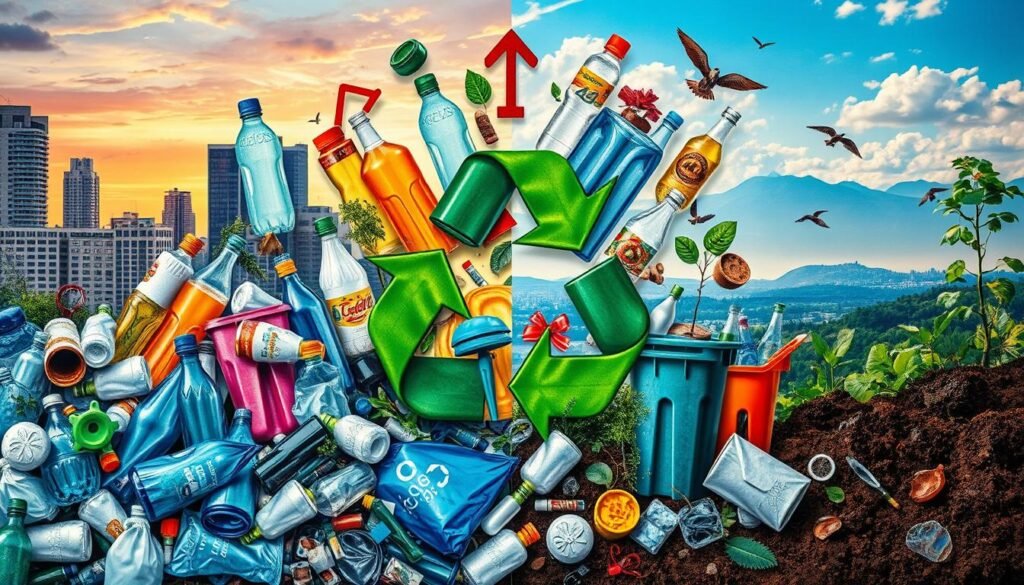
Finally, it’s essential to note that we could avert over 107 million metric tons of CO2 emissions if the remaining 79% of recyclable residential materials in the U.S. were captured14. Recycling initiatives reveal a promising trajectory amidst challenges, underscoring the critical need for continuous improvement and innovation in recycling technologies and practices15.
E-waste and Advanced Recycling Challenges
The issue of electronic waste is a growing concern as we continue to see an increase in the production and disposal of electronic devices. In 2016, the world generated 44.7 million metric tons of electronic waste, with the U.S. responsible for 6.3 million tons, accounting for 14% of the global total17. E-waste makes up 70% of the toxic waste generated today, posing severe environmental threats if improperly handled17. The environmental cost of e-waste is significant due to the hazardous materials contained within these devices. From lead and mercury to cadmium, these substances can contaminate soil and water, affecting both human health and ecosystems.
Efforts to manage the issue of electronic waste have led to the development of innovative recycling technologies. Researchers have identified non-toxic solvents that can recover polycarbonate plastics efficiently17. Moreover, 81 countries have implemented e-waste legislation to tackle this problem efficiently18. However, despite these advances, e-waste generation still outpaces formal recycling by a ratio of five to one18.
The e-waste recycling industry is faced with the intricate task of conscientiously dismantling electronic devices to extract reusable materials such as precious metals and plastics17. Innovations continue to emerge, from automated sorting technologies to Design for Disassembly principles, aimed at modernizing the recycling process and making it more cost-effective18.
We must recognize the considerable challenges in recycling the complex polymer composition found in electronics. Plastics used in electronic devices are more intricate than those used in single polymer items like soda bottles, making recycling difficult17. The continuous evolution of recycling methodologies is essential to mitigate the environmental effect of e-waste and reduce the reliance on raw material extraction.
The importance of proper e-waste disposal cannot be overstated, especially as it impacts efforts to mitigate global plastic waste. Approximately 50% of plastics are used for single-use applications like packaging, contributing significantly to the waste stream19. Innovations in the e-waste recycling industry, including the creation of mobile recycling units and the use of AI algorithms, present promising developments in our fight against electronic waste18.
Conclusion
An effective recycling system is paramount for ensuring recycling effectiveness, sustainable practices, and environmental stewardship. Throughout this article, we have explored the various facets of recycling, from the complexity of plastic recycling to the challenges associated with coffee cups and e-waste. What stands out is that our collective effort and awareness in managing waste and recycling can significantly reduce environmental impact.
While only 9% of plastic has been recycled, and merely 12% incinerated, a staggering 79% has found its way into landfills or the natural environment, emphasizing the urgent need for improved recycling practices20. The reduction in energy use and greenhouse gas emissions when recycling plastic materials is around 70-80%, highlighting the significant benefits of recycling over producing new plastics21. Additionally, advanced mechanical recycling methods, suitable for about 90% of standard plastics, are proof that effective recycling solutions are within our reach and must be implemented widely21.
As consumers and stewards of the environment, we must enhance our understanding of product materials, their recyclability, and proper disposal methods to amplify our recycling effectiveness. With around 2.5 million plastic bottles thrown away every hour in America, there is a critical need to adopt sustainable practices and reduce waste22. By managing our consumption and waste, we can contribute significantly to environmental stewardship, ensuring that future generations inherit a cleaner, more sustainable planet.


